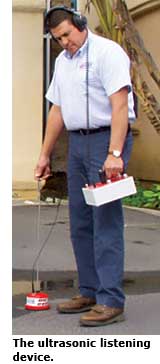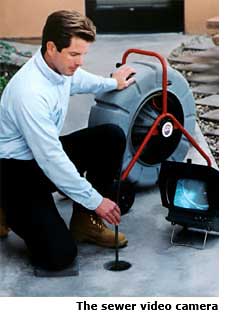Leak Detection Experts - Page 2

While Norman's job has gone well, it might not be over. There is a chance there might be a second leak. Christian Macaulay, the American Leak Detection franchise co-owner for the North Bay, based out of San Rafael, points out that "generally, you can only find one leak at a time'' because pressure will dissipate at the first hole in the line and not make it to the second. American Leak Detection routinely performs a second pressure test, after a repair, to determine whether there are any additional leaks.

The leak search at the Norse home was fairly straightforward, but certainly not all are. Leaks can be so tiny, hardly any air will seep out. They can be covered by so much concrete that it's hard to hear them.
Since most Eichlers were built with domestic plumbing running under the slab, this scenario makes a leak particularly difficult to locate without sophisticated instruments. That's why American Leak Detection and companies like it maintain a repertoire of sophisticated modern detection devices.
A line locator uses an electromagnetic transmitter that charges metal pipes and even electric wires. The mild magnetic charge then registers on a hand-held antenna or 'wand.' This technique is used to identify where utility lines are located within a structure. It can't be used on radiant heat systems, though, because the radiant tubing is coiled-too close to itself, about a foot apart, making the fields indistinguishable.

The sewer video camera also uses an electromagnetic transmitter, but its main purpose is to explore blockage or leaks in large-diameter sewer pipes such as those in domestic lines. A small, inch-wide lens connects to a length of fiber-optic cable running through conduit—like an eyeball on the head of a plumbing snake.
Having an electromagnetic transmitter on the end allows one to follow the camera's progress through the pipe, mapping out the line while simultaneously locating blockage or leaks. This technique can be used on sewer pipes two inches in diameter or wider.
With their domestic water lines located underneath roughly six inches of concrete, Eichlers can make for a tricky project when detecting a leak. In this instance, or in the case of a very small leak, companies use a detection device called a dielectric molecular analyzer, also called a 'sniffer.'
This sensitive device detects helium, or sometimes hydrogen, atoms in the air. Since helium atoms are much smaller than atmospheric air, they can pass through smaller leaks, which might not be flowing heavily enough to detect with the listening device or other devices.
With an analyzer, the system is charged with helium or a combination of helium and hydrogen. The atoms are small enough to pass through the concrete as well as the leak, and since they are lighter than air, they tend to travel upward. Wherever the sniffer detects the atoms, the leak is directly below.

The first step in leak detection is usually to find out whether there is, in fact, a leak in the system. For radiant heat, this can be done by pressurizing the system with air and measuring how much, if any, pressure is lost over time.
Another method used to appraise the general state of a radiant system is thermal imaging, a fascinating technique that photographs changes in temperature using an infrared camera. "I first bought this [thermal imaging] system to detect moisture in mold inspections," says Tony Eldon, whose San Rafael-based Bay Area Property Inspections includes the technique as part of its roster of whole-house inspections for residential and commercial properties.
When using thermal imaging, Eldon routinely points the 'thermal camera' at a wall or roof to pinpoint water leeching through a weak wall, or a crack near a door or window. "Thermal imaging allows me to see where water is getting into a structure," Eldon says.
The camera registers cool temperatures as blue and warm as red, with the range of color between the two representing the spectrum of heat. Water seeping into a wall might look like a green swath, while a leak in a radiant system may appear as a red splotch.
The camera is sensitive enough that Eldon says he can map out an entire radiant heat system; revealing where the tubing is in the floor, the temperature of the tubing, and any leaks that may be yet undetected.
The camera itself looks like "one of those big old Polaroids," says Eldon, but that does not mean it is as simple to use. Eldon typically discourages homeowners from purchasing these devices themselves because, he says, "it was much more expensive than I would have liked."




